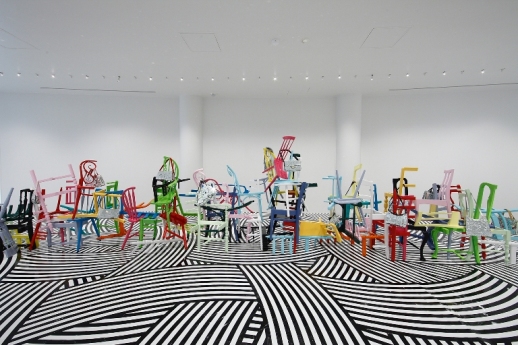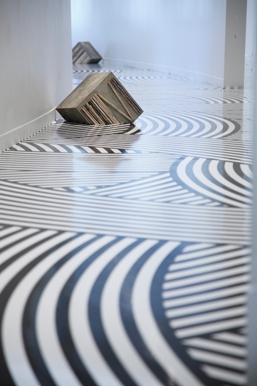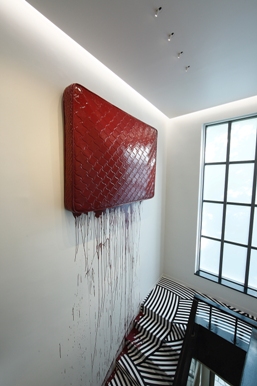Vintage Vinyl
Jim Lambie has made a career out of dorm rooms. Specifically, your cool older brother’s room circa 1978. Psychedelic patterns in wild colors, piles of old album covers, and posters of music idols all feature prominently in Lambie’s oeuvre, though lava lamps are conspicuous by their absence. This guy hit adolescence in the heyday of punk and disco, and recovery seems to be taking him a while.
“Unknown Pleasures” exhibits a series of works that Lambie and his team of assistants installed at the Hara Museum in December last year. The show includes several of the Scottish artist’s trademarks: a vibrantly colored sculpture made of deconstructed chairs and mirrored handbags (‘Train in Vain’), a series of black-and-white posters of pop-culture idols overlaid with fragments of floral oil paintings (‘Found Flower Paintings’), multi-knobbed doors leading nowhere (‘Maybelline,’ ‘Plastic Ono,’ and ‘Kinda Blue’).
 © Jim Lambie and Hara Museum of Contemporary Art
© Jim Lambie and Hara Museum of Contemporary Art
And herein lies the rub. I admire some of Lambie’s work, I really do. He is a master at creating disorienting environments. But how often can an artist—especially one working in the genre of site-specific conceptual art—productively repeat a trademark move?
Lambie is perhaps best known for his patterned floor surfaces, which he makes using vinyl tape. In most cases, the tape echoes the outlines of the space, inviting the viewer to think about the interactions between art and architecture, two-dimensional and three-dimensional work, decoration and design.
For this show, however, he has used the tape to create fan-shaped arcs in simple black and white (the work as a whole is called ‘The Strokes’). At first, this seemed appropriate: the Hara, after all, is housed in a High Modernist structure, a former residence designed by Jin Watanabe. Monochromatic arcs would surely meet with Bauhaus approval. But a little research reveals that Lambie has used this pattern before: in a show at Boston’s Museum of Fine Art last year, the same pattern appeared as a backdrop for the same colorful chairs that now make up ‘Train in Vain.’ How site-specific is that? (See a previous review of Lambie’s trademark stripes here on TABlog.)
 © Jim Lambie and Hara Museum of Contemporary Art
© Jim Lambie and Hara Museum of Contemporary Art © Jim Lambie and Hara Museum of Contemporary Art
© Jim Lambie and Hara Museum of Contemporary Art
Frankly, I felt cheated by this exhibition. Over and over again, I would find myself excited about particular works, only to discover that they were not as original as they seemed. ‘I Didn’t Know I Loved You Til’ I Saw You Rock ‘N’ Roll’ – which is, to my mind, the strongest piece here – is a good example. The work consists of a mattress mounted onto the wall above the stairs. It is coated in high-gloss paint of a lurid maroon color that inevitably evokes blood as it drips down the wall and pools on the stair treads. Lambie has said that he chose to mount the piece here, where the viewer is nearing the house’s former bedrooms, because the mattress is a symbol of domesticity. Pretty cool, right? Well, yeah, until you realize Lambie has made other mattresses in other colors for other shows in institutional, not domestic, settings.
Maybe I’m asking too much. Lambie is a musician and DJ as well as a visual artist, and he often draws parallels between the two worlds. Perhaps it is useful for us viewers, too, to think of him as a rock star, as David Bowie instead of Rembrandt. Musicians must often perform the same material night after night, in venue after venue, and though you always want to believe that they’re playing your favorite song just for you, you’re wrong. I guess the international art market is getting to be the same way.
(Readers interested in seeing footage of the installation process and interviews with the artist should visit the Museum’s website here.)
Jessica Niles DeHoff
Jessica Niles DeHoff



